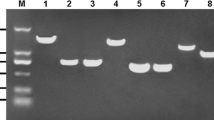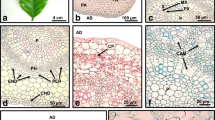Abstract
Laticifers are highly specialized cells present in over 20 plant families. They are well defined in planta. In vitro development of laticifers was also observed in some plants, but uncertain in the callus cultures of rubber tree, one of the most economically important latex producing plants. In the present study, we provide evidence that laticifer cells present in the callus cultures of rubber tree by histochemical and immunohistochemical studies. They present in the callus mainly as separate non-elongated form, a novel morphology different from the morphology of laticifer cells in planta, excluding their origin from explants. The occurring frequency of laticifer cells in the callus was genotype-dependent and negatively correlated with the somatic embryogenetic ability, suggesting that the presence of laticifer cells in the callus inhibit somatic embryogenesis in tissue culture of rubber tree. The genotypes PR107, RRIM600, Reyan8-79, and Reyan7-33-97 with lower embryogenetic ability compared to Haiken 2 had more laticifer cells, and laticifer clusters were only observed in these genotypes.





Similar content being viewed by others
Abbreviations
- 2,4-D:
-
2,4-Dichlorophenoxyacetic acid
- KT:
-
6-Furfurylaminopurine
- NAA:
-
1-Naphthaleneacetic acid
- SD:
-
Standard deviation
References
Biesboer DD, Mahlberg PG (1978) Accumulation of non-utilizable starch in laticifers of Euphorbia heterophylla and E. myrsinites. Planta 143:5–10
Charbit E, Legavre T, Lardet L, Bourgeois E, Ferriere N, Carron MP (2004) Identification of differentially expressed cDNA sequences and histological characteristics of Hevea brasiliensis calli in relation to their embryogenic and regenerative capacities. Plant Cell Rep 22:539–548
Chen XT, Wang ZY, Wu HD, Zhang XJ (2002) A new planting material of Hevea brasiliensis-self-rooting juvenile-type clone. Chin J Trop Crops 23:19–23
Da Cunha M, Gomes VM, Xavier-Filho J, Attias M, de Souza W, Miguens FC (2000) The laticifer system of Chamaesyce thymifolia: a closed host environment for plant trypanosomatids. Biocell 24:123–132
Datta SK, De S (1986) Laticifer differentiation of Calotropis gigantea R. Br. ex Ait. in cultures. Ann Bot 57:403–406
David DB, Paul GM (1981) Laticifer starch grain morphology and laticifer evolution in Euphorbia (Euphorbiaceae). Nord J Bot 1:447–457
Hagel JM, Yeung EC, Facchini PJ (2008) Got milk? The secret life of laticifers. Trends Plant Sci 13:631–639
Han KH, Shin DH, Yang J, Kim IJ, Oh SK, Chow KS (2000) Genes expressed in the latex of Hevea brasiliensis. Tree Physiol 20:503–510
Hao B-Z, Wu J-L (2000) Laticifer differentiation in Hevea brasiliensis: induction by exogenous jasmonic acid and linolenic acid. Ann Bot 85:37–43
Ko JH, Chow KS, Han KH (2003) Transcriptome analysis reveals novel features of the molecular events occurring in the laticifers of Hevea brasiliensis (para rubber tree). Plant Mol Biol 53:479–492
Konno K, Hirayama C, Nakamura M, Tateishi K, Tamura Y, Hattori M, Kohno K (2004) Papain protects papaya trees from herbivorous insects: role of cysteine proteases in latex. Plant J 37:370–378
Mahlberg PG (1993) Laticifers: an historical perspective. The Bot Rev 59:1–23
Martin MN (1991) The latex of Hevea brasiliensis contains high levels of both chitinases and chitinases/lysozymes. Plant Physiol 95:469–476
Milburn JA, Ranasinghe MS (1996) A comparison of methods for studying pressure and solute potentials in xylem and also in phloem laticifers of Hevea brasiliensis. J Exp Bot 47:135–143
Monacelli B, Valletta A, Rascio N, Moro I, Pasqua G (2005) Laticifers in Camptotheca acuminata Decne: distribution and structure. Protoplasma 226:155–161
Murashige T, Skoog F (1962) A revised medium for rapid growth and bioassays with tobacco tissue cultures. Physiol Plant 15:473–497
Sando T, Hayashi T, Takeda T, Akiyama Y, Nakazawa Y, Fukusaki E, Kobayashi A (2009) Histochemical study of detailed laticifer structure and rubber biosynthesis-related protein localization in Hevea brasiliensis using spectral confocal laser scanning microscopy. Planta 230:215–225
Shi Z, Hu Z (1965) A histological method for rubber-bearing tissues of plants. Act Bot Sinica 13:179–182
Subroto T, van Koningsveld GA, Schreuder HA, Soedjanaatmadja UM, Beintema JJ (1996) Chitinase and beta-1,3-glucanase in the lutoid-body fraction of Hevea latex. Phytochemistry 43:29–37
Suri SS, Ramawat KG (1995) In vitro hormonal regulation of laticifer differentiation in Calotropis procera. Ann Bot 75:477–480
Tan DG, Zhang J, Sun XP (2005) Tissue culture of Hevea brasiliensis Muëll.Arg. Plant Physiol Commun 41:674–678
Tan DG, Wu Y, Zhang J (2008) Green fluorescent background of different materials of Hevea brasiliensis in vitro. Chin J Trop Crops 29(1):23–26
Wang ZY, Wu HD, Chen XT (1989) Desirable characteristics of anther somatic plants of Hevea brasiliensis. Chin J Trop Crops 10:17–23
Wang YL, Li WG, Wu JL, Hao BZ, Lin WF (2005) Histological studies on in vitro somatic embryogenesis from anther culture of Hevea brasiliensis. J Rubber Res 8:120–129
Wilson KJ, Mahlberg PG (1977) Investigations of laticifer differentiation in tissue cultures derived from Asclepias syriaca L. Ann Bot 41:1049–1054
Wilson HM, Street HE (1975) The growth, anatomy and morphogenetic potential of callus and cell suspension cultures of Hevea brassiliensis. Ann Bot 39:671–682
Yamamoto H, Tabata M (1989) Correlation of papain-like enzyme production with laticifer formation in somatic embryos of papaya. Plant Cell Rep 8:251–254
Yuan XH, Yang SQ, Xu LY, Wu JL, Hao BZ (1998) Characteristics related to higher rubber yield of Hevea brasiliensis juvenile-type clone GL1. J Rubber Res 1:125–132
Acknowledgments
This research was supported by the National Natural Science Foundation of China (No. 31070637) and National Nonprofit Institute Research Grant of CATAS-ITBB (No. ITBBZD0711).
Author information
Authors and Affiliations
Corresponding author
Additional information
Communicated by F. Sato.
Electronic supplementary material
Below is the link to the electronic supplementary material.
299_2011_1019_MOESM1_ESM.doc
Autoinfluorescence of callus tissue of rubber tree. a1 and b1 Hand-made sections under normal light. a2 and b2 The same sections as in a1 and b1 under UV light showing the influorescence (DOC 128 kb)
Rights and permissions
About this article
Cite this article
Tan, D., Sun, X. & Zhang, J. Histochemical and immunohistochemical identification of laticifer cells in callus cultures derived from anthers of Hevea brasiliensis . Plant Cell Rep 30, 1117–1124 (2011). https://doi.org/10.1007/s00299-011-1019-9
Received:
Revised:
Accepted:
Published:
Issue Date:
DOI: https://doi.org/10.1007/s00299-011-1019-9




